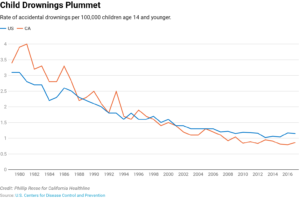News and Events
Consumer Product Safety Commission- Pool or Spa Submersion: Estimated Nonfatal Drowning Injuries and Reported Drownings, 2023 Report
Read the report here
Drowning Prevention Foundation Featured on Make the Minute Matter
We are honored to be featured on Make the Minute Matter. Please check out our story here: https://www.maketheminutematter.org/stories/nadina-story
Unintentional drowning deaths among children aged 0-17 years: United States, 1999-2019
Citation Spencer MR, Hedegaard H, Warner M. NCHS Data Brief 2021; (413): 1-8. Copyright (Copyright © 2021, United States National Center for Health Statistics) DOI unavailable PMID unavailable Abstract "Key findings Data from the National Vital Statistics System,...
Safer California Unintentional Injury Prevention Virtual Conference
Register Now for the Safer California Unintentional Injury Prevention Virtual Conference November 17th and 18th, 2020 It is more important than ever to attend this unintentional injury prevention conference. Learn how successful prevention programs are thriving...
Business community Finance Training
Business world finance classes will highlight how to create your business with first starting up the fiscal plan for a new business. Many of the successful company owners know how much they're going to become earning prior to them getting started. This knowledge is...
DPF mourns the loss of one of its own
Dear Colleagues – It is with great sadness to report the passing of Dr. Joseph Paul Barankin, husband and love of her life to Catherine Barankin, Executive Director, CA Coalition for Children’s Safety and Health. Joe passed away quietly at his home Thursday, August...
Drowning Rates Drop Thanks to New Laws
Copied from California Healthline (July 22, 2019): Some welcome news at the height of summer swimming season: Children are far less likely to drown in California than they were in the 1980s — and child drowning rates have continued to fall even in the past decade,...
Drowning Rates Dropped
Child Drowning Rates Drop As Communities Adopt Stricter Building Codes Some welcome news at the height of summer swimming season: Children are far less likely to drown in California than they were in the 1980s — and child drowning rates have continued to fall even in...
Drowning Prevention Month
Image reads: Office of the Governor May 2019 Drowning Prevention Month This Summer, many Californians will enjoy outdoor activities involving water and swimming. Our Golden State has abundant sources of water, including hundreds of miles of Pacific Ocean coastline,...


